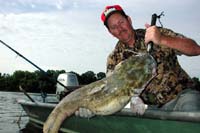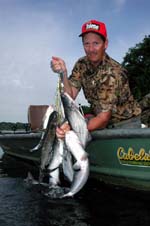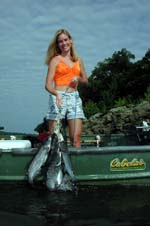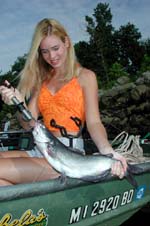
|
Features
|
|
|
|
Books
|
|
|
|
Fun & Games
|
|
|
|
Contact Us
|
|
|
John's Journal... Entry 254, Day 3
HOW TO FISH SUMMERTIME CATFISH
Below Dams and in Main Lakes
 Editor's
Note: "Don't want no bream or crappie, Only one fish that makes me happy:
Catfish, catfish." (Taken from the musical "Pumpboys & Dinettes") Plenty
of anglers across the U.S. share the sentiments of this song from "Pumpboys
and Dinettes." They love the fun of matching baits to the seasons of the
year and the places where they fish to catch cats, and they enjoy the
delicious white meat of catfish. Although many anglers believe that throwing
a stink bait out on the bottom of any river in the summer will catch catfish,
to consistently take more cats on every outing, you need to know where
the fish most likely will occur, what they will eat in these spots, and
what conditions will cause them to feed most actively. You can check with
biologists, local anglers and area sporting-goods stores to learn what
catfish prefer to eat in your part of the state at each time of the year.
Several factors affect when and what catfish eat. The temperature of the
water governs how actively catfish feed because the enzyme action in a
catfish's stomach doubles with each 8-degree increase in water temperature.
The hotter the weather becomes, the more catfish feed. Since most catfish
prefer a dark habitat, they eat mostly at night during the hottest, sunniest
weather. My friend, Phil King of Corinth, Mississippi, an expert angler
and guide for catfish who primarily fishes Pickwick Lake on the Alabama/Mississippi/Tennessee
border, says that during the summer you'll most likely catch big catfish
an hour or two after daylight with the secondary peak time from 8:30 a.m.
until 10:30 a.m.
Editor's
Note: "Don't want no bream or crappie, Only one fish that makes me happy:
Catfish, catfish." (Taken from the musical "Pumpboys & Dinettes") Plenty
of anglers across the U.S. share the sentiments of this song from "Pumpboys
and Dinettes." They love the fun of matching baits to the seasons of the
year and the places where they fish to catch cats, and they enjoy the
delicious white meat of catfish. Although many anglers believe that throwing
a stink bait out on the bottom of any river in the summer will catch catfish,
to consistently take more cats on every outing, you need to know where
the fish most likely will occur, what they will eat in these spots, and
what conditions will cause them to feed most actively. You can check with
biologists, local anglers and area sporting-goods stores to learn what
catfish prefer to eat in your part of the state at each time of the year.
Several factors affect when and what catfish eat. The temperature of the
water governs how actively catfish feed because the enzyme action in a
catfish's stomach doubles with each 8-degree increase in water temperature.
The hotter the weather becomes, the more catfish feed. Since most catfish
prefer a dark habitat, they eat mostly at night during the hottest, sunniest
weather. My friend, Phil King of Corinth, Mississippi, an expert angler
and guide for catfish who primarily fishes Pickwick Lake on the Alabama/Mississippi/Tennessee
border, says that during the summer you'll most likely catch big catfish
an hour or two after daylight with the secondary peak time from 8:30 a.m.
until 10:30 a.m.
 When
fishermen discuss catfishing, many anglers' minds flash to images of bubbling,
swift-moving tailrace waters. The swift water of rivers below power plants
and dams generally hold large concentrations of cats. One day, all day,
I watched a fisherman and his wife load their boat with catfish as they
drifted through the swift water below a dam and bumped the bottom with
heavy leads and shad gut for bait. At times, I moved to within 8 or 10
feet of these folks to try and catch catfish as they did. However, they
consistently took four or five catfish to my one. At the end of the day,
I introduced myself and asked how they had fished. "We're fishing the
grooves, and you're not," they replied. Because I could see no grooves
in the water - just the bubbling discharge from the 12-discharge holes
of the turbines of the hydroelectric plant - I asked, "What grooves?"
The anglers explained about the invisible grooves created by the current
present beneath the water at the dam. Once I tried their tactic, I, too,
became successful. Some years ago when I fished a tailrace area, I watched
as two anglers anchored in the middle of the tailrace and caught catfish
on almost every cast. They fished until they took their limits and then
left the region. I knew they hadn't fished a groove because their boat
sat in the middle of the turbulent water, downriver from a discharge hole.
When
fishermen discuss catfishing, many anglers' minds flash to images of bubbling,
swift-moving tailrace waters. The swift water of rivers below power plants
and dams generally hold large concentrations of cats. One day, all day,
I watched a fisherman and his wife load their boat with catfish as they
drifted through the swift water below a dam and bumped the bottom with
heavy leads and shad gut for bait. At times, I moved to within 8 or 10
feet of these folks to try and catch catfish as they did. However, they
consistently took four or five catfish to my one. At the end of the day,
I introduced myself and asked how they had fished. "We're fishing the
grooves, and you're not," they replied. Because I could see no grooves
in the water - just the bubbling discharge from the 12-discharge holes
of the turbines of the hydroelectric plant - I asked, "What grooves?"
The anglers explained about the invisible grooves created by the current
present beneath the water at the dam. Once I tried their tactic, I, too,
became successful. Some years ago when I fished a tailrace area, I watched
as two anglers anchored in the middle of the tailrace and caught catfish
on almost every cast. They fished until they took their limits and then
left the region. I knew they hadn't fished a groove because their boat
sat in the middle of the turbulent water, downriver from a discharge hole.
 Utilizing
my depth finder, I reconnoitered the area. I discovered a large boulder
that came up from the bottom about 3 feet. Making a mental note of the
boulder's location, I moved upstream about 15 yards and tied a three-way
swivel to my main line. I attached a drop lead to the bottom eye of the
three-way swivel. I tied 20 inches of 20-pound test monofilament leader
material on the third eye of the swivel along with a No. 1 hook and baited
with cut shad. I bumped the lead along the bottom until it hit the big
boulder. Then I moved my lead around the boulder to where the catfish
attacked. That proved to me that anytime you can find a large, underwater
boulder in swift water, especially in a tailrace area, you usually can
pinpoint catfish stacked-up like cordwood behind the boulder. My fishing
buddy Phil King likes to vertical troll below dams. According to King,
"I use rod holders and put out multiple poles. I like double-bait rigs
on each pole, which lets you utilize a combination of cut bait, chicken
livers and Strike King's Catfish Dynamite Dough. Too, you can dip your
cut bait in the different Strike King Catfish Dip Baits."
Utilizing
my depth finder, I reconnoitered the area. I discovered a large boulder
that came up from the bottom about 3 feet. Making a mental note of the
boulder's location, I moved upstream about 15 yards and tied a three-way
swivel to my main line. I attached a drop lead to the bottom eye of the
three-way swivel. I tied 20 inches of 20-pound test monofilament leader
material on the third eye of the swivel along with a No. 1 hook and baited
with cut shad. I bumped the lead along the bottom until it hit the big
boulder. Then I moved my lead around the boulder to where the catfish
attacked. That proved to me that anytime you can find a large, underwater
boulder in swift water, especially in a tailrace area, you usually can
pinpoint catfish stacked-up like cordwood behind the boulder. My fishing
buddy Phil King likes to vertical troll below dams. According to King,
"I use rod holders and put out multiple poles. I like double-bait rigs
on each pole, which lets you utilize a combination of cut bait, chicken
livers and Strike King's Catfish Dynamite Dough. Too, you can dip your
cut bait in the different Strike King Catfish Dip Baits."
 To
learn more about Phil King and his fishing and guide service, you can
call him at (662) 286-8644, e-mail him at pking@tsixroads.com,
or go to www.h2ow.com/catfish/.
For more information about catching catfish, order John E. Phillips' book,
"The Masters' Secrets of Catfishing," at www.nighthawkpublications.com/fishing/masterscatfish.htm.
To learn more about fishing below the dam at Pickwick, contact the Hardin
County Convention and Visitor’s Bureau at info@tourhardincounty.org,
call 731-925-8181 or 800-552-3866, or visit www.tourhardincounty.org.
Pickwick Landing State Park offers fishing, boating, hiking, camping,
swimming and golf. Lodging includes the lakeside inn with over 100 rooms,
cabins that sleep eight and a campground that contains 48 sites with grill
and electric/water hookup at each site. A restaurant at the park offers
delicious southern cuisine. Call 731-689-3135 or 800-250-8615 to learn
more.
To
learn more about Phil King and his fishing and guide service, you can
call him at (662) 286-8644, e-mail him at pking@tsixroads.com,
or go to www.h2ow.com/catfish/.
For more information about catching catfish, order John E. Phillips' book,
"The Masters' Secrets of Catfishing," at www.nighthawkpublications.com/fishing/masterscatfish.htm.
To learn more about fishing below the dam at Pickwick, contact the Hardin
County Convention and Visitor’s Bureau at info@tourhardincounty.org,
call 731-925-8181 or 800-552-3866, or visit www.tourhardincounty.org.
Pickwick Landing State Park offers fishing, boating, hiking, camping,
swimming and golf. Lodging includes the lakeside inn with over 100 rooms,
cabins that sleep eight and a campground that contains 48 sites with grill
and electric/water hookup at each site. A restaurant at the park offers
delicious southern cuisine. Call 731-689-3135 or 800-250-8615 to learn
more.
TOMORROW: MAIN LAKES AND AT VARIOUS DEPTHS
Check back each day this week for more about HOW TO FISH SUMMERTIME CATFISH ...
Day 1 - Small Streams And
Little Rivers
Day 2 - Large River Cats
Day 3 - Below Dams and in Main Lakes
Day 4 - Main Lakes and at Various Depths
Day 5 - What Cats Like